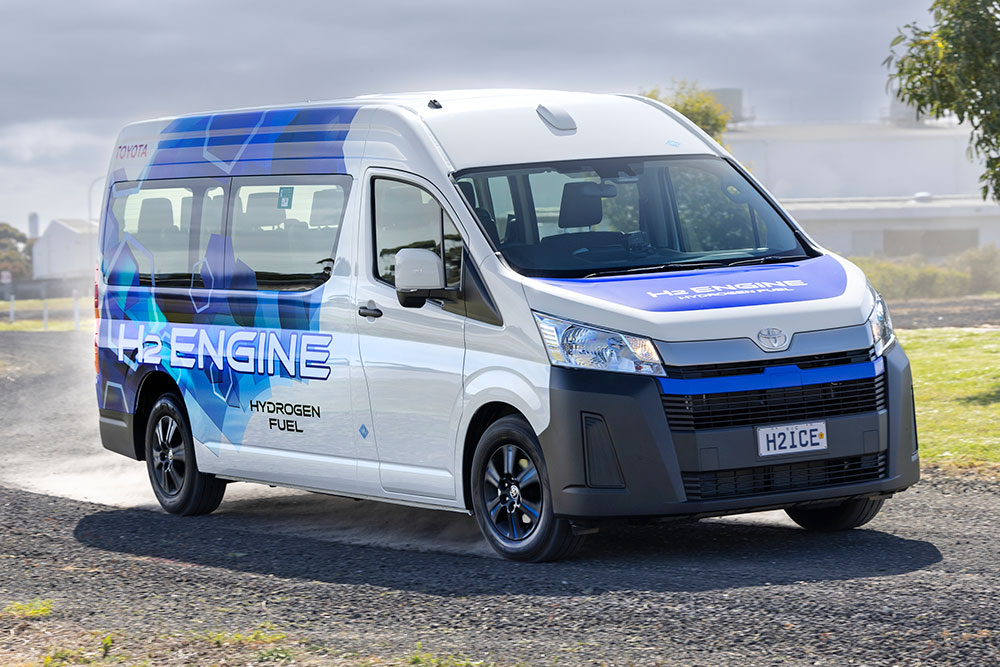Toyota trials hydrogen-fuelled V6-powered HiAce

Motorsport has long been used by car makers as a test bed for new technologies but rarely does motorsport-bred tech find its way into a humble delivery van like the Toyota HiAce.
Toyota Australia has unveiled a prototype HiAce that’s powered by a hydrogen-fuelled internal combustion engine that traces its lineage to a Corolla Sport hatch race car.
The hydrogen-fuelled hot hatch raced in four rounds of the 2021 Super Taikyu series in Japan.
Now, the technology behind that hydrogen-fuelled internal combustion engine has found its way into a HiAce van which will undergo a customer pilot program in Australia.
The new powertrain technology promises ultra-low CO2 tailpipe emissions and is described by Toyota as the latest step in its multi-pronged approach to decarbonisation.

The Japanese automotive giant has been criticised in some quarters for being slow to embrace battery electric vehicle technology, with the first Toyota EV the bZ4X SUV not due in Australian showrooms until February 2024, following several delays.
But Toyota remains the undisputed leader in sales of hybrid electric vehicles (HEV) globally and backs a multi-pathway approach to decarbonisation that includes significant investments in carbon-neutral fuels as well as hybrid electric, plug-in hybrid electric, battery electric and fuel-cell electric vehicles.
Toyota said it used the experience and knowledge gained from testing the hydrogen-fuelled internal combustion engine under extreme motorsport conditions to develop the technology further to meet emissions standards before adapting it for use in the HiAce.
The company said the HiAce was chosen to pilot the new technology because its design allowed the engine to be installed up front and the hydrogen fuel tanks under the floor, minimising the impact on internal load space and payload.

It is also the type of vehicle that is often used for short ‘back to base’ commercial operations, whether transporting people in the 12-seat HiAce Commuter bus or goods in the HiAce van.
This is important because of the scarcity of hydrogen refuelling infrastructure in Australia, with operators likely to need to refuel at Toyota’s dedicated facilities in Altona, Victoria.
The prototype Hydrogen HiAce uses a V6 turbo-petrol engine available in some overseas markets for the LandCruiser 300 Series, which has been modified to run on compressed hydrogen gas, using a direct-injection system that enables it to meet Euro VI emission standards.
With maximum outputs of 120kW/354Nm the hydrogen powertrain is slightly more powerful but has less torque than the 2.8-litre turbocharged four-cylinder diesel that powers production versions of the HiAce (130kW/450Nm), but the prototype drives its rear wheels via a 10-speed automatic transmission, where the diesel HiAce has only six-speeds.
Toyota said burning hydrogen in the combustion engine resulted in almost zero CO2 tailpipe emissions, although the process of igniting hydrogen in the engine generates small amounts of oxides of nitrogen (NOx), which are reduced to meet Euro VI emission standards by using a selective catalytic reduction system.
Learn more about electric vehicles
The prototype’s three hydrogen tanks are like those used in the second-generation Toyota Mirai FCEV (Fuel Cell Electric Vehicle) which began limited trials here in Australia in 2021, with a fleet of 20 sedans made available to select business and government fleets.
But the process of burning hydrogen in a combustion engine is entirely different to the hydrogen fuel cell technology used in the Mirai, which is an electric vehicle powered by electricity generated by the hydrogen fuel cell, as opposed to electricity from a battery.
Toyota said it would use the Australian HiAce prototype to optimise the powertrain by enhancing hydrogen storage, improving combustion, and exploring the possibility of adding hybrid technology.
The pilot program is aimed at fast-tracking the development of the new powertrain, with the aim of bringing vehicles powered by hydrogen-fuelled internal combustion engines to full commercialisation, and will see a variety of potential customers using the vehicle for either commuter or delivery-type operations.
Toyota said the prototype HiAce would be driven in real-world conditions by Australian companies interested in the potential for fit-for-purpose commercial vehicles with ultra-low CO2 tailpipe emissions.

Toyota Australia President and CEO Matthew Callachor said the local company was proud to have been selected by its parent company in Japan to operate this Australian-first pilot program.
“This technology offers the potential for Toyota to produce vehicles that meet the practical requirements of commercial customers while dramatically reducing CO2 tailpipe emissions,” Mr Callachor said.
“Australia is the perfect place to run such a program with our federal and state governments having already committed $6.3 billion in funding for hydrogen projects under the National Hydrogen Strategy.”
The first customer to use the hydrogen HiAce will be CPB Contractors, one of Australia’s leading designers and builders of large-scale infrastructure, who will use the Commuter version of the HiAce to transport workers to projects around Melbourne.
The Hydrogen HiAce pilot program builds on other Toyota Australia hydrogen initiatives including commissioning Victoria’s first hydrogen production, storage and refuelling facility at Altona in 2021 and the long-term lease of second-generation Mirai sedans to various businesses and organisations.
In October this year, Toyota signed a memorandum of understanding with Hyundai Australia, Ampol and Pacific Energy to develop hydrogen refuelling infrastructure.
Toyota has also committed to assembly of fuel-cell generators at its Altona facility for French energy supplier EODev and will distribute the generators throughout Australia and New Zealand.
Related topics
Things to note
The information in this article has been prepared for general information purposes only and is not intended as legal advice or specific advice to any particular person. Any advice contained in the document is general advice, not intended as legal advice or professional advice and does not take into account any person’s particular circumstances. Before acting on anything based on this advice you should consider its appropriateness to you, having regard to your objectives and needs.
Insurance Products (excluding Travel Insurance) are issued by RACQ Insurance Limited ABN 50 009 704 152 (RACQI) and arranged by its agent, RACQ Distribution Services Pty Ltd (RDS) ABN 35 116 361 650, AFSL 567130 and RDS' authorised representatives (including RACQ Operations Pty Ltd ABN 80 009 663 414, AR No. 234978 (RACQO). Conditions, limits and exclusions apply. RDS and RACQO are in the RACQ group of companies. One of the companies in the RACQ group of companies has a minority shareholding in RACQI.
RDS and RACQO have not taken your personal objectives, circumstances or needs into account when preparing advice regarding insurance products and you will need to consider whether the advice is appropriate for you. Read the Product Disclosure Statement (PDS) and any applicable Supplementary PDS before making a purchase decision on this product. You can also access our Target Market Determinations on this website. RDS receives a commission from RACQI for the policies it arranges. RACQO receives fees paid for services it provides to RDS. Further details about remuneration are available on request prior to purchasing.
Banking and loan products issued by Members Banking Group Limited ABN 83 087 651 054 AFSL/Australian credit licence 241195 trading as RACQ Bank. Terms, conditions, fees, charges and lending policies apply. This is general advice only and may not be right for you. This information does not take your personal objectives, circumstances or needs into account. Read the disclosure documents for your selected product or service, including the Financial Services Guide and the Terms and Conditions, and consider if appropriate for you before deciding.
Except for RACQ Bank, any RACQ entity referred to on this page is not an authorised deposit-taking institution for the purposes of the Banking Act 1959 (Cth). That entity’s obligations do not represent deposits or other liabilities of RACQ Bank. RACQ Bank does not guarantee or otherwise provide assurance in respect of the obligations of that entity, unless noted otherwise.
RACQ Bank subscribes to the Customer Owned Banking Code of Practice which establishes higher standards than the law requires. The Code reflects modern consumer expectations and developments in approaches to issues such as consumer vulnerability, guarantors, and supporting customers through financial hardship. Please read our Customer Owned Banking Code of Practice page for more information.
RACQ Operations Pty Ltd (ABN 80 009 663 414 AR 000234978) and Members Travel Group Pty Ltd (ABN 45 144 538 803 AR 000432492) are acting as an Authorised Representative of the issuer of the insurance, Tokio Marine & Nichido Fire Insurance Co., Ltd. (ABN 80 000 438 291 AFSL 246 548). Any advice set out above is general in nature only, and does not take into account your objectives, financial situation or needs. Before purchasing any travel products, please consider the RACQ Travel Insurance Product Disclosure Statement (PDS) and the Target Market Determinations (TMDs) that apply to these products. Whilst the PDS outlines the Terms and Conditions of these products, the TMDs outline the intended class of customers that comprise the target market for these travel products. This will allow you to consider which products best suit your objectives, financial situation and needs and consider the products appropriateness to your personal circumstances. TMDs also outline matters involving the distribution and the review of these products. The PDS, Supplementary PDS and TMDs for each travel product can be found here.
